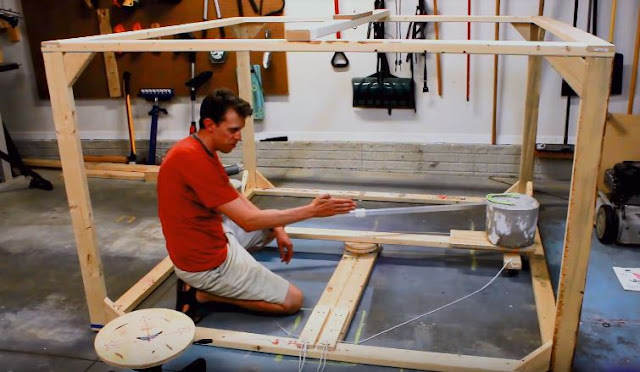 |
| YouTube Screenshot (https://www.youtube.com/watch?v=E1lCjq4IzJw) |
By Andrew Bennett
Cavendish Experiment Build Update
At this point, the device itself is built except for plastic sheeting covering the whole thing. The next step is to set up the lasers and mirrors for making extremely precise measurements of angles.Cavendish Gravity Experiment FAQs
I've received a lot of feedback and questions on my previous Cavendish videos. Here's a look at the frequently asked questions."Doesn't his need to be done in a vacuum to eliminate air currents as a variable?"
This will not be conducted in a vacuum. As far as I can tell, that would make this nearly impossible. Removing the air from the container requires a significant amount of air movement, which would get the torsional balance swinging. Since air resistance is really the only force slowing down that swinging, you'd be stuck with way too much movement to make a good measurement. I also don't have the money for the equipment and materials required for something like that, so it's a moot point."How can you measure the gravity from the concrete blocks (bowling balls in the old versions) when there are other objects nearby?"
Or related:"The only way you could measure the force of gravity from these blocks is if you took the device into space, really far from all other masses."
There are certainly other forces present. The idea in the Cavendish experiment is that the only force we allow to change is the gravitational forces from the pulling masses. As long as other forces stay consistent, we don't have to worry about them causing a change in the equilibrium position of the torsional balance.As a side note, I get so much joy when I read comments along the lines of, "Gravity isn't real. Your experiment is bad because the gravitational pull from _______ messed up the results, so now you can't prove gravity is real."
 | |
|
"Electric and magnetic forces could be responsible for the movement we see."
This is true and something I didn't really address in the previous versions of this experiment. I'll be trying a few different combinations of materials and setups to show that we get similar results with various methods of controlling for those forces. For example, in one version, I'll cover everything with conductive material and ground the conductor, so that we know it's all at zero charge."You shouldn't be near the device because your own gravitational force disrupts the system."
Again, quite true. For the measurement phases, I will be out of the area and letting the cameras run to get measurements remotely. I'll have to get near to move the masses into place again (still outside the sealed box), but I will wait until the pendulum reaches a stable swing in my absence to make the measurement.What's Next in the Cavendish Demo Series?
In the next video, we'll address the system for making the types of extremely precise angle measurements required for this experiment. To accomplish this, we'll be bouncing a laser off a mirror on the arm of the torsion balance and projecting it onto a giant protractor, then using the law of reflection to determine how much the system has moved. Please subscribe to this blog and my YouTube channel to receive update reminders. If you have any questions, please send them my way. I'm happy to help!
Miss a Post in This Physics Series?
Part 1: Recreating the Cavendish Gravity Experiment: My First 2 AttemptsPart 2: Get to Know the Math Behind the Cavendish Gravity Experiment
Part 3: Cavendish Gravity Experiment: How to Evaluate and Choose the Materials
Part 4: How to Build the Torsion Balance
Part 5: How to Measure the Torsion Constant
Comments
Post a Comment